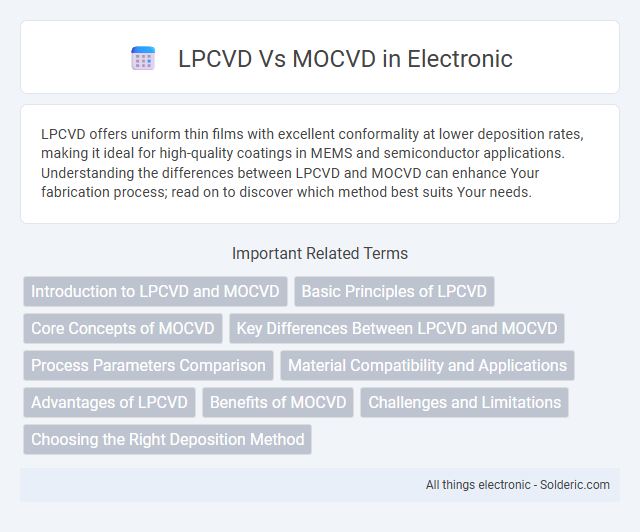LPCVD offers uniform thin films with excellent conformality at lower deposition rates, making it ideal for high-quality coatings in MEMS and semiconductor applications. Understanding the differences between LPCVD and MOCVD can enhance Your fabrication process; read on to discover which method best suits Your needs.
Comparison Table
| Parameter | LPCVD (Low-Pressure Chemical Vapor Deposition) | MOCVD (Metal-Organic Chemical Vapor Deposition) |
|---|---|---|
| Process Pressure | Low pressure (0.1 - 1 Torr) | Near atmospheric to low pressure (10 Torr to atmospheric) |
| Precursors Used | Inorganic gases (e.g., SiH4, NH3) | Metal-organic compounds (e.g., TMAl, TMGa) |
| Deposition Temperature | Typically 400 - 900degC | Typically 500 - 1100degC |
| Material Types | Silicon, silicon nitride, polysilicon, oxides | Compound semiconductors like GaAs, InP, GaN |
| Film Uniformity | High uniformity over large wafers | Excellent uniformity with precise control |
| Growth Rate | Low to moderate (nm/min scale) | Moderate to high (nm/min scale) |
| Application | Microelectronics, MEMS, dielectric layers | Optoelectronics, LEDs, lasers, power devices |
| Cost | Lower operational cost | Higher cost due to complex precursors |
Introduction to LPCVD and MOCVD
LPCVD (Low-Pressure Chemical Vapor Deposition) and MOCVD (Metal-Organic Chemical Vapor Deposition) are advanced thin-film deposition techniques widely used in semiconductor manufacturing and materials science. LPCVD operates at reduced pressure to deposit uniform, high-quality films like silicon nitride and polysilicon, offering excellent step coverage and conformality. MOCVD relies on metal-organic precursors to create compound semiconductor layers such as GaAs and InP, enabling precise control over composition and thickness for optoelectronic device fabrication.
Basic Principles of LPCVD
LPCVD (Low-Pressure Chemical Vapor Deposition) operates by introducing precursor gases into a reactor chamber maintained at reduced pressure, enabling uniform thin film deposition on semiconductor wafers through thermally driven chemical reactions. This process achieves excellent conformality and uniform thickness control by minimizing gas-phase reactions and particle formation compared to atmospheric pressure CVD techniques. Key parameters such as temperature, pressure, and gas flow rates are precisely controlled to tailor film properties for applications in microelectronics and MEMS device fabrication.
Core Concepts of MOCVD
Metal-Organic Chemical Vapor Deposition (MOCVD) utilizes volatile metal-organic precursors to deposit thin films through chemical reactions on heated substrates, enabling precise control over composition and thickness. This technique supports complex multilayer structures and alloy formation, essential for semiconductor devices such as LEDs and high-electron-mobility transistors (HEMTs). MOCVD's capacity for uniform, high-purity epitaxial layers at relatively low substrate temperatures distinguishes it from LPCVD, which primarily relies on gas-phase reactants and higher temperatures.
Key Differences Between LPCVD and MOCVD
LPCVD (Low-Pressure Chemical Vapor Deposition) operates under sub-atmospheric pressures, enabling uniform thin films and conformal coatings on complex wafer topographies, while MOCVD (Metal-Organic Chemical Vapor Deposition) utilizes metal-organic precursors at higher pressures for precise control of compound semiconductor layers like GaN and InP. LPCVD typically yields high-quality polysilicon and silicon nitride films with excellent step coverage but slower deposition rates, whereas MOCVD offers superior control over composition, doping, and alloy uniformity critical for optoelectronic devices. Temperature ranges in LPCVD are generally higher (around 550-900degC), compared to MOCVD processes that commonly operate between 450-750degC, influencing film properties and precursor selection.
Process Parameters Comparison
LPCVD (Low-Pressure Chemical Vapor Deposition) typically operates at pressures between 0.1 to 10 Torr and temperatures ranging from 500degC to 900degC, enabling uniform thin films with high conformity. MOCVD (Metal-Organic Chemical Vapor Deposition) functions at lower pressures, often below 1 Torr, with adjustable temperatures from 400degC to 1200degC, providing precise control over film composition and thickness. Your choice between LPCVD and MOCVD depends on the desired deposition rate, film quality, and material system, as MOCVD offers greater versatility for complex compound semiconductors compared to LPCVD's robustness in simpler films.
Material Compatibility and Applications
LPCVD (Low Pressure Chemical Vapor Deposition) excels in depositing uniform, high-quality silicon-based films such as silicon nitride and polysilicon, making it ideal for MEMS and semiconductor device fabrication. MOCVD (Metal-Organic Chemical Vapor Deposition) offers superior material compatibility with III-V compounds like GaAs and InP, crucial for optoelectronic devices and high-frequency applications. Your choice hinges on the specific material systems and functional requirements of advanced electronic and photonic components.
Advantages of LPCVD
LPCVD offers superior film uniformity and conformality at lower processing pressures, reducing defects and improving device performance in semiconductor manufacturing. It enables high-quality silicon nitride, polysilicon, and oxide layers with excellent step coverage on complex wafer topographies, making it ideal for MEMS and microelectronics applications. Your production benefits from LPCVD's cost efficiency and scalability due to reduced gas consumption and compatibility with batch processing.
Benefits of MOCVD
MOCVD offers precise control over film composition and thickness, enabling the growth of high-quality semiconductor layers essential for advanced electronic and optoelectronic devices. This technique supports complex material systems, including ternary and quaternary compounds, providing superior uniformity and scalability compared to LPCVD. Your production process benefits from MOCVD's higher deposition rates and ability to create sharp interfaces critical for device performance.
Challenges and Limitations
LPCVD faces challenges such as limited deposition rates and difficulties achieving uniform films on complex 3D structures, restricting its scalability for high-throughput manufacturing. MOCVD encounters limitations including high precursor costs, complex precursor chemistry, and sensitivity to process parameters, which affect reproducibility and material quality. Both techniques require precise control over temperature and pressure to minimize defects and ensure consistent film properties in semiconductor and optoelectronic applications.
Choosing the Right Deposition Method
LPCVD (Low-Pressure Chemical Vapor Deposition) offers superior conformality and uniformity for high-quality thin films, making it ideal for applications requiring precise thickness control and low defect density. MOCVD (Metal-Organic Chemical Vapor Deposition) excels in depositing complex compound semiconductors like GaN and InP with excellent composition control and high growth rates, suitable for optoelectronic devices. Selecting between LPCVD and MOCVD depends on material requirements, desired film properties, and device application, with LPCVD favored for Si-based layers and MOCVD for advanced compound semiconductors.
LPCVD vs MOCVD Infographic

 solderic.com
solderic.com